
Article by Dr. Paresh Saxena
What is ShrAddha?
Ancestral worship (पितृ पूजा/pitR pUjA) in the Sanatana Vedic Dharma is often referred to as ShrAddha (श्राद्ध in Devanagari/ zrAddha in Harvard-Kyoto), translated in English as something ‘being truthfully done.’ The word has its roots in shrat (श्रत्=truth) and dha (धा=to do). The sets of beliefs and rituals of ShrAddha are practiced utmost truthfully. In the Sanatana Vedic Dharma, the Pitars (पितरः=the manes) are considered to be devas (देव=gods). The main ritual of ShrAddha is offering oblations of water and black sesame seeds (called तिलोदक तर्पण =tilodaka tarpaNa) and offering cakes of barley and paddy flour kneaded in water or milk (पिण्डदान=piNDa-dAna) to the manes. The two offerings together are termed as the पिंडोदक क्रिया (piNDodaka kriyA).
Who is worshipped at ShrAddha?
Manes in the Sanatana Vedic Dharma are represented by three generations of forefathers, who are equated with the Vedic divinities वसु Vasu, रुद्र Rudra and आदित्य Aditya, respectively. In the Vedic pantheon, the Vasus are Earthly divinities, the Rudras abide in the atmosphere and the Adityas shine in the Sky. Hence, the nomenclature of the manes as divinities corresponds to their remoteness from the living generation. Descent is always patrilineal in the Sanatana Vedic Dharma, and therefore, manes include the parents, grandparents and great grandparents of a living descendant both from his father’s gotra and his mother’s gotra. The Pitars of each generation are always worshipped as a couple. A गोत्र (gotra =natal group) signifies common descent from the same ancestors in the remote past; for the purpose of ShrAddha the gotra of the last three generations of forefathers is taken into account. Father’s gotra is ranked first and mother’s gotra is ranked second. The manes are invoked by their gotra, intergenerational relationship, name during the lifetime, and their status as the Vedic divinity, in that order. The ‘स्वधा‘ (svadhA) mantras are uttered while performing पिंडोदक क्रिया/ piNDodaka kriyA and paying obeisance to the Pitars. It is believed that the essence of the offerings is accepted by the manes, who exist in ethereal (वायव्य/ vAyavya) form, directly or through the three divinities and thus, both are propitiated.

Who can perform a ShrAddha?
The पिंडोदक (piNDodaka) is offered by the son of the family, in the first place. It is a set principle in the Sanatana Vedic Dharma that three debts, respectively the देव ऋण, ऋषि ऋण, and पितृ ऋण, that is, the debt of gods, sages and forefathers (deva RNa, RSi RNa and pitR RNa) are required to be settled during the life time of any individual. The debt of forefathers is settled by raising a पुत्र (son) who offers pindodaka to the three previous generations of ancestors. If the son is not available, the wife, daughter, grandchild, sibling or kin who shared common property with the deceased are entitled for performing ShrAddha. Demonstrative ancestry is however, not a prerequisite for receiving worship at a ShrAddha. ShrAddha can be performed even for a childless relative, or the Guru, a friend, a servant, etc. All such departed souls are invoked by their name and relationship with the performer of the ShrAddha and conferred upon the status as Vasu during the ritual. Parents are however, not supposed to do ShrAddha for their children, and so an elder brother for his younger brother. However, an exception is made if the ShrAddha is performed at Gaya.

Where ShrAddha can be performed?
ShrAddha is always a domestic ritual to be performed at one’s home on a clean ground with southward slope. It is never done on someone else’s land and the rituals are never displayed publicly. The only exception to this rule is when the ritual is being conducted at a place like hill, river bank, water body, natural grove, and forest, or at temples situated in sacred places (tirthas). There are seven sacred places in India, called the मोक्षदायिनी पुरी (mokSa dAyinI purI), namely, Ayodhya, Dwarika, Hardwar, Kanchi, Mathura, Ujjain, and Varanasi (Kashi), where it is believed, one can liberate the souls of his ancestors by performing piNDodaka kriyA. Some other places in the Indian sub-continent are even more celebrated for performing ShrAddha. Gaya in Bihar tops this list. The other important places are Badrinath in Uttarakhand, Kurukshetra in Haryana, Pushkar in Rajasthan, Prayagaraja in Uttar Pradesh, Amarkantaka in Madhya Pradesh, Gangasagar in West Bengal, Puri in Odisha, Nasik in Maharashtra, Tirupati in Andhra Pradesh, Rameshvaram in Tamil Nadu, Kumbakonam in Kerala, Srirangam in Karnataka, Siddhapura in Gujarat, Mattan in Anantnag of Kashmir, and Muktinatha in district Mustang of Nepal.
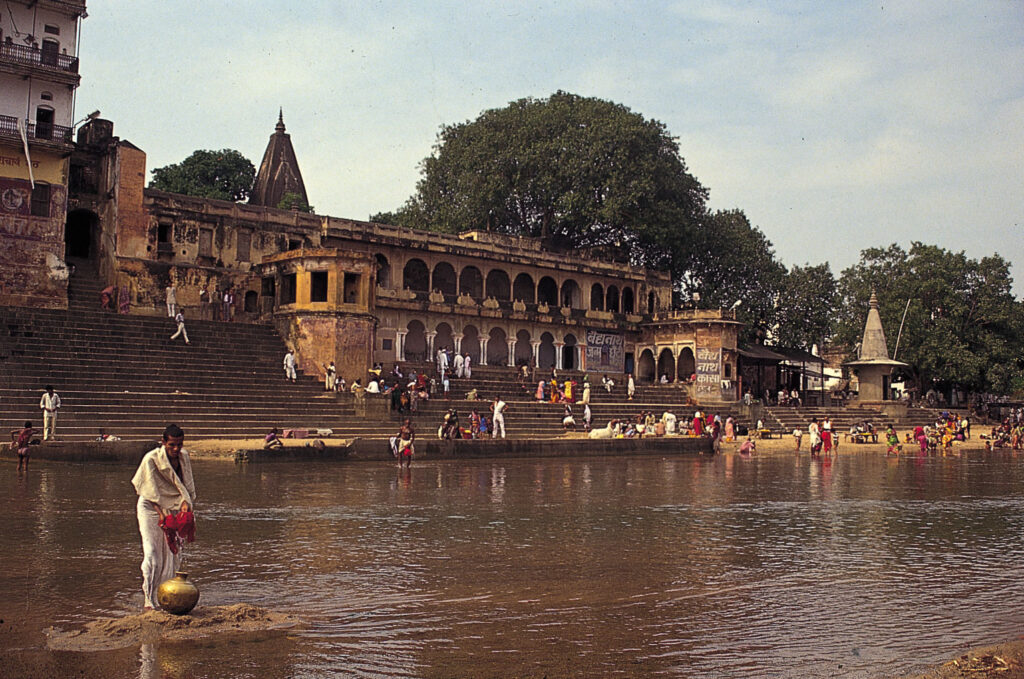
When is ShrAddha performed?
As an informal daily rite (नित्य कर्म nitya karma), tarpana is offered to the devas, sages and forefathers and hence, पितृ यज्ञ (pitR yaJja) is included among the five great sacrifices. A full-fledged पिंडोदक क्रिया (piNDodaka KriyA) is performed on Amavasya (अमावस्या is the ‘no moon date’ prior to conjunction with new moon) every month. Such a ShrAddha is called ‘पार्वण श्राद्ध’ (pArvaNa zrAddha) as Amavasya is taken as a ‘पर्व’ (parva means a node) in the Sanatana Vedic calendar (पंचांग/ paNcAnga). The ritual of annual ShrAddha of a deceased ancestor is performed on the date and month of the passing away of the deceased for the three years after death. That is called an ‘एकोद्दिष्ट श्राद्ध’ (ekoddiSTa zrAddha). Further, performing ShrAddha is obligatory during the period of 16 days, beginning with the full moon of Bhadrapada and ending on Amavsya of the Ashwina (September-October), which is called ‘पितृ-पक्ष’ (pitR-pakSa) in the Sanatana Vedic calendar, and is yet, another special type of a पार्वण श्राद्ध (pArvaNa zrAddha). This particular fortnight in the annual calendar is again held as a ‘पर्व’ (parva). The pitR pakSa mandates ShrAddha to be performed universally, irrespective of social or financial status. If the exact date of the passing away of individual ancestors is not available, their ShrAddha can be performed on the last day of this fortnight, that is called the महालया अमावस्या (mahAlayA amAvasyA; translated as the ‘No Moon Date of Great Harmony’), as it is believed that all the PitRs descend on this date to receive ShrAddha worship from the living ones of their family. Hence, it is also called सर्व पितृ श्राद्ध ( sarva pitR ShrAddha that is, ShrAddha for All the Forefathers) and being the last day of the fortnight, it is also called पितृ विसर्जनी अमावस्या ( pitR visarjanI amAvasyA, that means the farewell of the forefathers on the ‘no moon day’). A ShrAddha is also desirable at the onset of an eclipse (ग्रहण), or on the day of zodiac transition of the Sun (संक्रान्ति/ saMkrAnti), on equinox (विषुव) or on any day while one is visiting a tirtha (तीर्थ= place of pilgrimage). Thus, a wide range of options is available for the living to perform the ShrAddha of their forefathers, whereas, it is obligatory during the pitR pakSa.

The best time to perform a ShrAddha ritual is the कुतप वेला (kutapa velA), that is the hour of the day after half-past eleven. The manes are never invoked and worshipped after the sunset.
What is the Code of Conduct for ShrAddha?
The code of conduct for the subject who undertakes ShrAddha is sacrosanct. He must be clean, both physically and mentally. Water, being the universal cleansing agent, is used for bathing without application of soap. Clean clothes are put on. Celibacy and control of anger and sorrow is essential for mental purity. Males may have their head and face shaven, especially when performing ekoddiSTa ShrAddha at home or piNDodaka at a sacred place. He may put on simple clothes and do not use any perfume or cosmetics. Those entitled for a sacred thread may wear it on the right shoulder during the ritual or use an uttarIya (a long white cloth) in its place. ShrAddha is neither mourning, nor a festivity. It is a liturgy to be conducted through learned priests in a serene atmosphere and with utmost simplicity. The expenditure towards rituals, feeding the priests and others and donations should commensurate with the financial capacity of the subject and borne as an unhesitating adherence to duty towards the forefathers. Fasting i.e.उपवास is observed until the priests and others have been fed.

How is ShrAddha performed?
Central to the rites and rituals of ShrAddha are its offerings (tarpaNa). Water, cow milk, uprooted kusha grass (कुश Desmostachya bipinnata), black sesame seeds (कृष्ण तिल), honey and natural incense are mixed and offered as oblation (अर्घ्य/arghya) to the ancestors. The पिण्ड (piNDa) or cakes of cereal are made by kneading barley and paddy flour in water and milk or after boiling rice grains in cow’s milk in an earthen pot on wood fire. Edible seeds of millet, peas and mustard are additional condiments and they satisfy birds who feed on it.
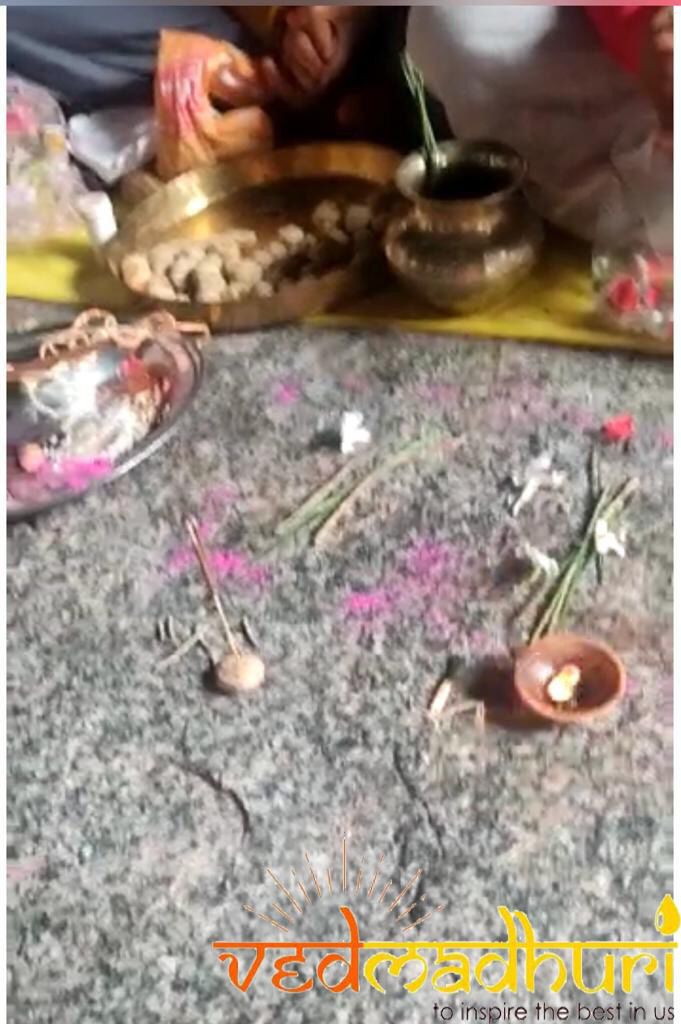
The following specific gestures are prescribed during the ShrAddha:
- The subject should face South, called दक्षिणाभिमुख (dakSiNAbhimukha) in Sanskrit;
- sit with his right knee flexed on the ground, called भू-लग्न-सव्य-जानु (bhU-lagna-savya-jAnu) position in Sanskrit;
- wear the sacred thread/ long cloth यज्ञोपवीत/ उत्तरीय (yaJjopavita/uttarIya) on his right shoulder and under the left armpit, called प्राचीनवीति/ अपसव्य (prAcInavIta or apasavya) in Sanskrit.

- The पिंडोदक क्रिया (piNDodaka kriya) is performed on Kusha being spread North-South.
- The libation (तर्पण)/offering of cereal cake (पिण्ड) should be made from right palm in between the index finger and thumb, called पितृ तीर्थ (pitR tIrtha) in Sanskrit.
- Kusha should be folded so that root and tip both overlap and face South, called दक्षिणाग्र कुश (dakSiNagra kuza) in Sanskrit.
- Three libations are made for each of the forefathers, called त्रीणि अंजली (trINi-aMjalI) in Sanskrit.
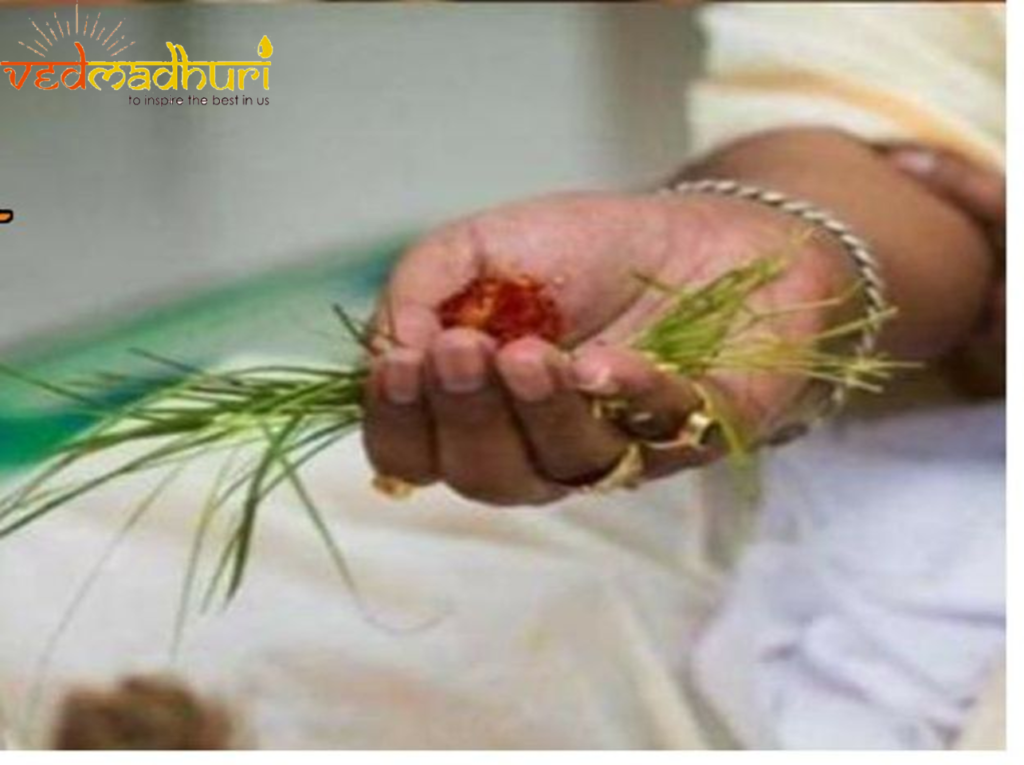
Each of the twelve pitRs are offered individual नमस्कार (namaskara) with folded hands and respectfully offered the ShrAddha: firstly father’s ancestors, than step mother (if that be the case), secondly mother’s ancestors, and lastly all other departed souls who are spaced according to intergenerational kinship or any specific relationship with the subject.

- The priests should be invited in odd numbers and they should face North उत्तराभिमुख (uttarAbhimukha in Sanskrit) and be seated on the left of the पिण्ड (piNDa) platform.
- ब्राह्मणभोज or feeding the Brahmanas is mandatory and they should always be served food first amongst all invitees.
- Food should always be served with both hands while a long cloth (उत्तरीय) is kept on the left shoulder.
- Food should be partaken in silence.
- Even if an unknown person, like a bagger, approaches during the feast, he has to be honoured and served food.
- Iron/steel is proscribed in all rituals of ShrAddha.
- All the articles used in ShrAddha should be absolutely clean and so be the food.
- Certain food items are proscribed in a ShrAddha feast: milk and ghee other than the Cow’s, Gram, red lentils, Sattu (roasted gram or barley flour), cucumber, black cumin, mustard, black lentils (unhusked urad), or any stale fruits or food items.
- Regional traditions are maintained; and while vegetarian food is the norm, in some regions, like Mithila, even fish and meat is permitted.
- The left over pindas and seeds are permitted to be consumed by animals and birds; in fact, eating by a cow and crow is held to be of ritualistic importance.
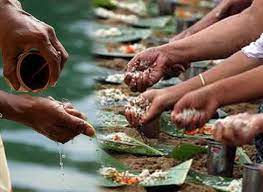
Specific Vedic mantras are uttered by the priest during the ritual which convey great meaning. Hence, it is absolutely desirable that the priest should have knowledge of Vedas and possess essential qualities of character. However, in places like Gaya, only traditional family priests are mandated to be engaged. They keep a record of ancestry of their clients, generations-by-generations. Offering and oblations to the manes is made along with स्वधा (svadhA) mantras (click) always.
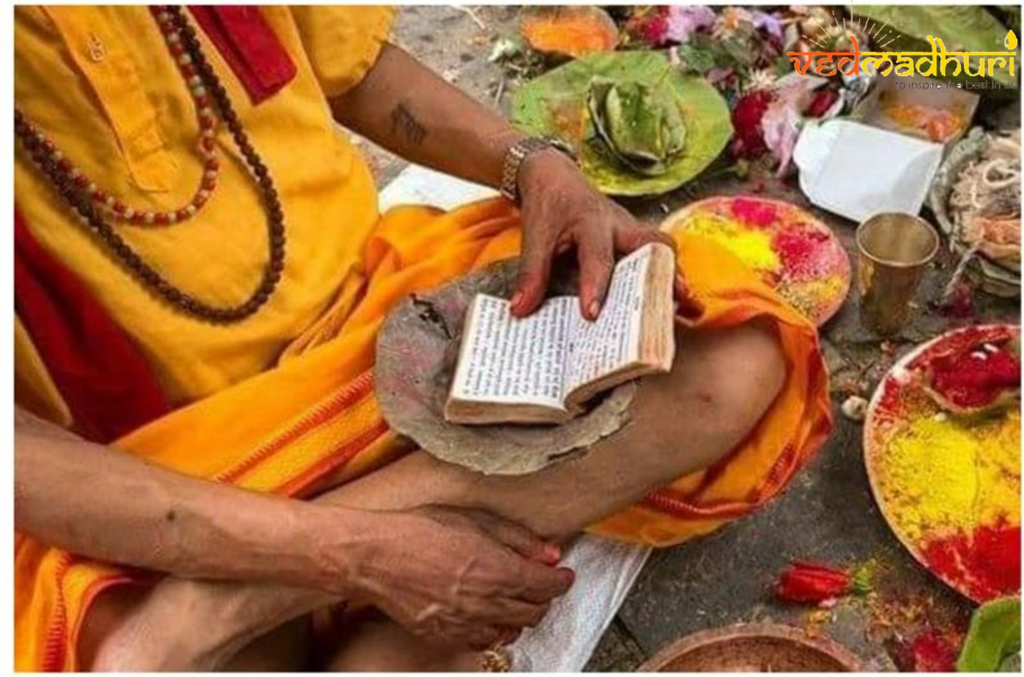
One of the important mantras of YajurVeda uttered at the time of tarpana during a ShrAddha is presented here along with its English Translation that will help the readers to appreciate the true spirit of ShrAddha: पितृभ्य: स्वधायिभ्य: स्वधा नमः। पितामहेभ्य: स्वधायिभ्य: स्वधा नमः। प्रपितामहेभ्य: स्वधायिभ्य: स्वधा नमः। अक्षन्पितरोऽमीमदन्त पितरोऽतीतृपन्त पितर: पितर: शुन्धध्वम्।।
To Fathers who claim SvadhA be SvadhA and homage!
To Grandfathers who claim SvadhA be SvadhA and homage!
To Great-grandfathers who claim SvadhA be SvadhA and homage!
The Fathers have eaten. The Fathers have rejoiced. The Fathers have been satisfied, Fathers, be ye purified. (YajurVeda 19.36 Griffith’s translation)

